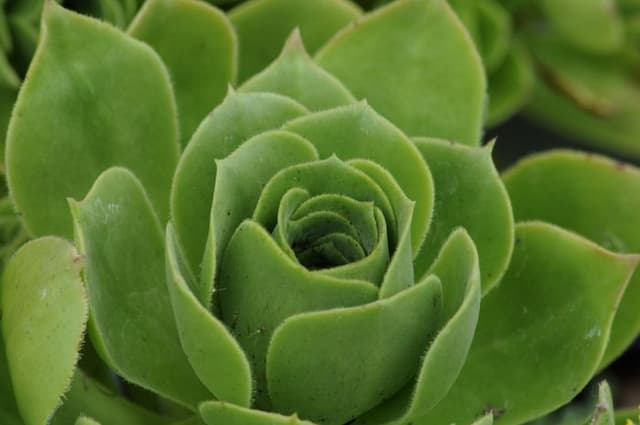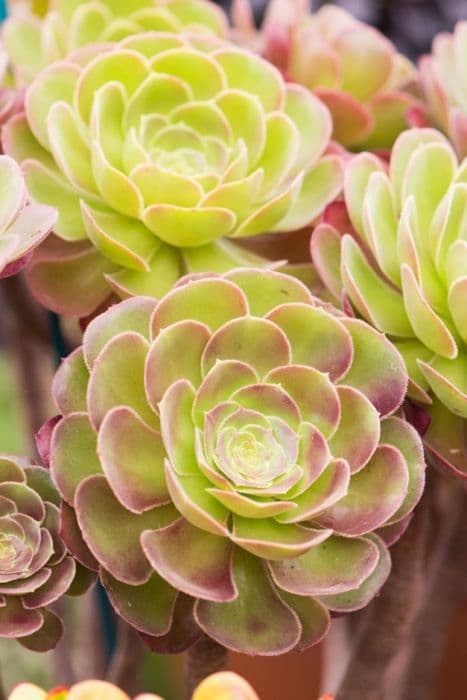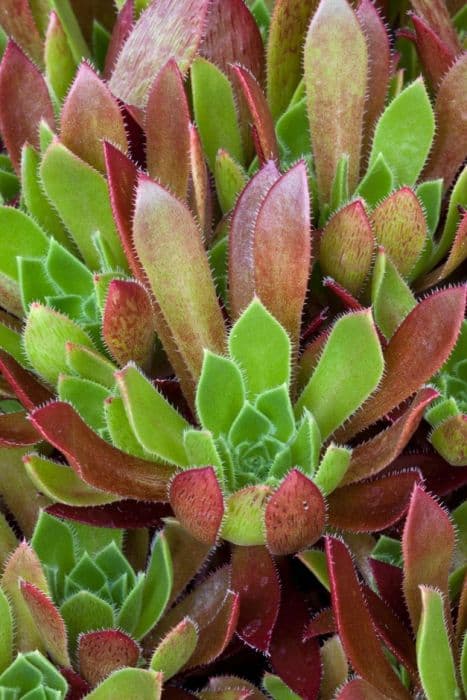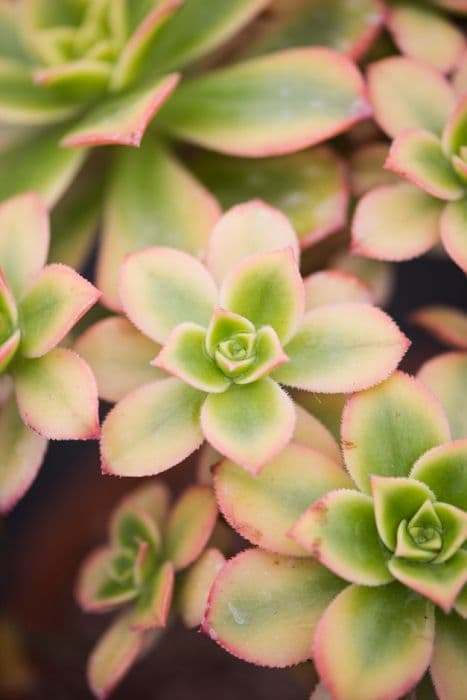Stewed Rhubarb Mountain Hylotelephium 'Stewed Rhubarb Mountain'

ABOUT
The Hylotelephium 'Stewed Rhubarb Mountain', commonly known as Stonecrop, showcases a striking appearance with its succulent features. This variety is particularly noted for its foliage that bears a resemblance to the deep, reddish hue of cooked rhubarb. The leaves are thick and fleshy, with a rounded or slightly ovate shape that is typical of many succulent plants. They are arranged in a dense, spiraling pattern around the stems, creating a lush and textured look. The Stonecrop produces clusters of small, star-shaped flowers that bloom in an eye-catching display. These blooms often come in shades that harmonize with the rich tones of the foliage, such as deep pink or red, and they attract a variety of pollinators like bees and butterflies. The contrasting colors between the flowers and the leaves make for a vivid and appealing contrast within the garden or container arrangements. Overall, the Stonecrop's appearance is one of robust vitality, with a palette that echoes the warm, earthy colors of a mountain landscape stewed in the hues of sunset. It is a hardy plant, well-suited to thriving in a range of conditions and makes for an excellent addition to rock gardens, borders, or as a ground cover where its descriptive name 'Stewed Rhubarb Mountain' paints a vivid image of its ornamental value.
About this plant
 Names
NamesFamily
Crassulaceae
Synonyms
Stewed Rhubarb Mountain, Stonecrop
Common names
Sedum telephium 'Stewed Rhubarb Mountain'
 Toxicity
ToxicityTo humans
Stonecrop, as Hylotelephium 'Stewed Rhubarb Mountain' is commonly known, is not highly toxic to humans. However, it may cause mild discomfort if ingested, such as an upset stomach, vomiting, or diarrhea. Handling the plant may also lead to skin irritation in some people. It is generally recommended to avoid eating any part of ornamental plants like stonecrop, as they are not intended for consumption.
To pets
Stonecrop may cause mild gastrointestinal upset in pets if ingested, including symptoms like vomiting or diarrhea. While it is not considered highly toxic to pets, it's still best to prevent them from eating this plant. If a pet consumes a large amount of stonecrop, it is advisable to monitor them for any signs of distress and consult with a veterinarian as a precaution.
 Characteristics
CharacteristicsLife cycle
Perennials
Foliage type
Deciduous
Color of leaves
Purple
Flower color
Pink
Height
1-2 feet (30-60 cm)
Spread
1-2 feet (30-60 cm)
Plant type
Succulent
Hardiness zones
3
Native area
Asia
Benefits
 General Benefits
General Benefits- Ease of Care: The Stonecrop is a hardy plant that requires minimal maintenance, making it ideal for beginners or those with a busy lifestyle.
- Drought Tolerance: It is highly resistant to drought, which is great for water conservation and regions with less rainfall.
- Attracts Pollinators: Stonecrop flowers are known to attract bees, butterflies, and other pollinators, contributing to the health of your garden's ecosystem.
- Seasonal Interest: With its colorful foliage and blooms, Stonecrop adds visual interest to gardens across multiple seasons, enhancing aesthetic appeal.
- Cold Hardiness: This plant is tolerant of cold temperatures, making it a suitable choice for gardens in cooler climates.
- Soil Adaptability: It can thrive in a variety of soil types, including poor soils, which reduces the need for soil amendments and fertilizers.
- Deer and Rabbit Resistance: Stonecrop is not favored by deer and rabbits, making it an excellent choice for gardens plagued by these animals.
 Medical Properties
Medical PropertiesThis plant is not used for medical purposes.
 Air-purifying Qualities
Air-purifying QualitiesThis plant is not specifically known for air purifying qualities.
 Other Uses
Other Uses- Artistic Inspiration: The richly-hued foliage and clustered blooms of the Hylotelephium can serve as inspiration for artists and photographers, who might capture the plant's texture and color in their works.
- Teaching Tool: Educators might use the Hylotelephium as an example in botany classes to demonstrate the characteristics of succulent plants, including their drought resistance and leaf structures.
- Ecological Studies: Ecologists might include the Hylotelephium in studies on plant resilience and adaptation to various climates, as it exhibits strong survival traits in different environments.
- Floral Arrangements: The stems and flowers of the Hylotelephium can be used in fresh or dried floral arrangements, contributing a unique texture and color that lasts even after drying.
- Culinary Presentation: While not typically consumed, the Hylotelephium's leaves may be used for decorative garnishing in high-end culinary presentations due to their striking appearance.
- Fashion Design: Fashion designers may use the silhouette and colors of the Hylotelephium as inspiration for patterns and textures in fabric design.
- Seasonal Decoration: The Hylotelephium can be incorporated into fall decorations and arrangements due to its autumnal color palette, adding natural beauty to seasonal displays.
- Companion Planting: Gardeners may use Hylotelephium as a companion plant in vegetable gardens to attract pollinators or provide ground cover that helps retain soil moisture.
- Green Roofing: The drought tolerance and low maintenance of the Hylotelephium make it a suitable plant for green roofing projects, where it can contribute to insulation and biodiversity.
- Container Gardening: Due to its compact growth habit, the Hylotelephium is ideal for container gardening, where it can serve as a striking visual element in mixed plant arrangements on patios or balconies.
Interesting Facts
 Feng Shui
Feng ShuiThe plant Stonecrop is not used in Feng Shui practice.
 Zodiac Sign Compitability
Zodiac Sign CompitabilityThe plant Stonecrop is not used in astrology practice.
 Plant Symbolism
Plant Symbolism- Resilience: Hylotelephium, commonly known as Stonecrop, is known for its hardiness and ability to thrive in poor soil and drought conditions, symbolizing endurance and the ability to persevere through tough times.
- Prosperity: With its succulent leaves that can store water, the Stonecrop represents abundance and the storage of wealth, reflecting an accumulation of resources.
- Tranquility: The easy care and robust nature of Stonecrop can symbolize peace and stress-free existence, suggesting that one can remain unbothered by the surrounding chaos.
- Survival: The Stonecrop’s ability to live with minimal water and care makes it a symbol of survival and adaptability in various circumstances.
- Longevity: As a perennial, Stonecrop represents long life and permanence, signifying lasting presence or eternal principles.
 Water
WaterFor the Stonecrop 'Stewed Rhubarb Mountain', water thoroughly but infrequently, allowing the soil to dry out completely between watering sessions. Typically, it should be watered approximately every 7-10 days during active growth in spring and summer, depending on temperature and humidity, with a reduction to once a month or less during the dormant period in winter. Generally, about 1/2 gallon per plant for each watering should suffice, ensuring that water penetrates the soil deeply to encourage strong root development. Adjust the amount based on the plant's size and the container's volume. Overwatering can lead to root rot, so it's crucial to provide adequate drainage and never let the plant sit in soggy soil.
 Light
LightStonecrop 'Stewed Rhubarb Mountain' thrives in full sun to partial shade conditions. Its ideal spot is where it can receive at least 6 hours of direct sunlight each day. If grown indoors, a south-facing window is optimal. However, in extremely hot climates, it benefits from some afternoon shade to prevent scorching, while maintaining a bright light environment to encourage robust growth and vibrant foliage color.
 Temperature
TemperatureStonecrop 'Stewed Rhubarb Mountain' is a hardy plant that can tolerate a wide range of temperatures, from as cold as -20°F to as warm as 90°F. Its ideal growing temperature is between 65°F and 75°F. It's important to ensure that the plant is not exposed to prolonged periods of extreme heat or cold, as this can cause stress and damage. It is cold-hardy and can survive winter temperatures without extra protection in many regions.
 Pruning
PruningPruning Stonecrop 'Stewed Rhubarb Mountain' is done primarily to maintain its shape, remove dead or damaged stems, and encourage bushier growth. The best time to prune is in late winter or early spring before new growth begins. It may also be lightly trimmed after flowering to remove spent blooms. Generally, pruning can be done annually or as needed when plants appear untidy.
 Cleaning
CleaningAs needed
 Soil
SoilThe best soil mix for Stonecrop, commonly known as Hylotelephium 'Stewed Rhubarb Mountain', is a well-draining, gritty mix like those used for cacti and succulents. Incorporate coarse sand or perlite for increased drainage and aeration. Aim for a slightly acidic to neutral soil pH of around 6.0 to 7.0 for optimal growth conditions.
 Repotting
RepottingStonecrop, or Hylotelephium 'Stewed Rhubarb Mountain', generally requires repotting every 2-3 years to ensure it has enough space to grow and refresh the soil. Repot in spring when the plant is emerging from dormancy for best results.
 Humidity & Misting
Humidity & MistingStonecrop, also known as Hylotelephium 'Stewed Rhubarb Mountain', prefers low to average humidity levels typical of most household environments. It does well in dry air and can tolerate some humidity but should not be in excessively humid conditions which could promote rot.
 Suitable locations
Suitable locationsIndoor
Place Stonecrop in bright light, well-draining soil, water sparingly.
Outdoor
Choose sunny spot, well-drained soil, water deeply but infrequently.
Hardiness zone
3-9 USDA
 Life cycle
Life cycle'Stewed Rhubarb Mountain' (often referred to by its genus, Hylotelephium or common name, Stonecrop), begins its life cycle as a seed, germinating in moist, well-draining soil in spring. The seedling establishes roots and shoots, gradually forming a succulent stem and fleshy leaves, indicative of its drought-tolerant nature. As it matures into a vegetative adult plant, it produces clumps of foliage and spreads through rhizomes or by dropping leaves that root to form new plants. During late summer to fall, the plant blooms with clusters of small, star-shaped flowers, typically in shades of pink to red, attracting pollinators. After flowering, the plant sets seed, and as temperatures drop, it may die back, with the fleshy leaves and stems desiccating if exposed to frost, but the root system remains alive. In spring, the plant resumes growth from the rootstock or from any surviving vegetation, repeating its life cycle.
 Propogation
PropogationPropogation time
Spring-Early Summer
Hylotelephium 'Stewed Rhubarb Mountain', more commonly known as Stonecrop, is best propagated by division or stem cuttings. The most popular method, however, is by stem cuttings. This technique is typically done in late spring or early summer. To propagate by stem cuttings, a healthy, non-flowering stem measuring about 2 to 4 inches long (5-10 cm) is cut from the parent plant. The cut end is allowed to callous over for a few days before being planted in well-draining soil. It’s important to keep the soil lightly moist until the cutting has rooted, which usually occurs within a few weeks. Once the cutting has established a sufficient root system, it can be transplanted to its final location.









